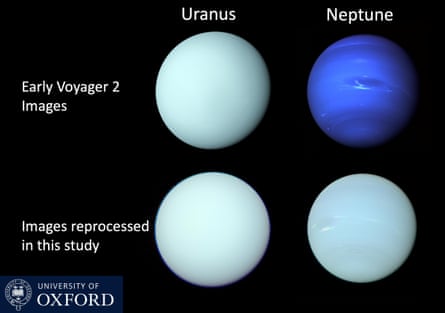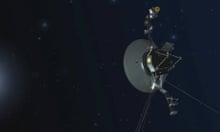It’s a colour beloved by interior designers, but it seems duck-egg blue is also splashed across our solar system, with research suggesting it is the true colour of both Uranus and Neptune.
The new work puts paid to the popular belief that Neptune has a deep blue hue, suggesting instead both planets are a similar colour – with Neptune only slightly more blue than Uranus.
“Uranus is still bland and rather boring looking, but Neptune looks fairly washed-out as well when you do the full true colour reconstruction,” said Prof Patrick Irwin, first author of the study at the University of Oxford.
The colour of the ice giants has long been known to be a result of high levels of methane in their atmospheres, a gas that absorbs green and red light. Research by Irwin and colleagues has previously suggested Neptune was the slightly bluer of the two planets because one of the layers of aerosol in its atmosphere was more transparent.
However, images constructed from data collected by the Nasa Voyager 2 spacecraft during flybys in the 1980s has led to a misconception around the planets’ true colours, with Neptune depicted as being deep blue because images of it were contrast-enhanced to accentuate its fainter features.
“Although these images were released including captions saying that they were ‘enhanced’ or ‘stretched’, these captions inevitably got separated from the images over time and have given rise to the longstanding and persistent misunderstanding of the relative colours of these two planets,” the researchers write.

The team’s new, true colour images of the planets reveal both have a pale blue-green colour, with very similar results obtained even when they used data from different instruments on the Hubble space telescope or data from the Voyager missions.
The research has also shed light on the mystery of why Uranus appears to change colour with its seasons. Observations have previously revealed that the planet appears to be greener during its summer and winter when its polar regions are pointing towards Earth and the sun.
after newsletter promotion
Using computer models, the team suggest this is not only down to the polar regions of Uranus having lower levels of methane, but also because a haze of frozen methane particles forms over the sun-facing pole, scattering light and hence increasing the reflection of green and red wavelengths.
But Irwin said questions remained, including why methane levels were lower over the poles of Uranus, and why such a haze would form over the warmer pole.
“There’s a whole lot about these planets that we just don’t understand,” he said, adding that to learn more, Nasa and the European Space Agency (ESA) needed to join forces and send a spacecraft to them.
“We need to actually go into orbit and drop a probe down so that we can see exactly what’s there, rather than trying to piece it together from remote-sensed observations,” he said.










